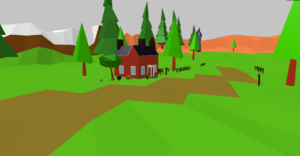I was plugging along converting my tree models to glTF by exporting them out of Blender as .glb files and replacing the references to the old .fbx files in the map when I found a piece of weird behavior. The glTF files I was loading into the world editor moved strangely. It seemed like each individual asset would move differently when selected and moved. This made absolutely no sense because the code to move any object is the same for all objects, but I could see it happening. I’ve now spent a few days investigating this and I finally figured out it was a bug in what I was selecting. My assets are structured like this (for now):
- Scene (Scene)
- Collider (Mesh)
- Asset (Group)
- Asset Mesh_0 (Mesh)
- Asset Mesh_1 (Mesh)
- etc.
OR
- Scene (Scene)
- Collider (Mesh)
- Asset (Mesh)
When an object only has one material applied to it (which will likely never happen with a production asset) the exported file contains a Scene object named “Scene” with two child objects that are Meshes, an object named “Collider” and an object named “Asset.” If an object has more than one material it follows the same patter except that the object named “Asset” is now a Group and contains children, one for each part of the Mesh to which a particular material is applied. So if the asset has three materials, there will be three child Meshes name Asset Mesh_0, Asset Mesh_1, and Asset Mesh_2.
Updating my selection code to handle both possibilities was not terribly difficult, but it took me a while to actually figure out this structure of the exported files. I’m sure it’s documented somewhere, but I’ve never actually seen it.
The problem I was seeing was caused by selecting the wrong object. If I select the Asset Mesh or Group then move it around, its transform is still ultimately affected by its parent Scene object. So if I move a selected Group like this strictly along the x-axis, but the parent Scene object is rotated along the y-axis, the resulting movement will be unexpected and it will move off of the global x-axis. Since each Scene object is rotated when it gets loaded I was seeing different translation behavior for each object and it was very confusing and frustrating. Now that I understand the structure of the loaded files a little better I can select the root Scene object and move it, and everything works the way I want it to.
One of the primary lessons I’ve learned through this whole project is that I have to just keep looking at it. When frustrations come up, and many have, if I just keep working on it a little at a time I will eventually get past the problem. Just last night I was seriously considering scrapping the whole thing and starting over with a 2d game engine like Phaser. Now I’m glad I didn’t because I didn’t even have to change much to make this work, just invest some time and effort into understanding what is actually happening inside THREE.
